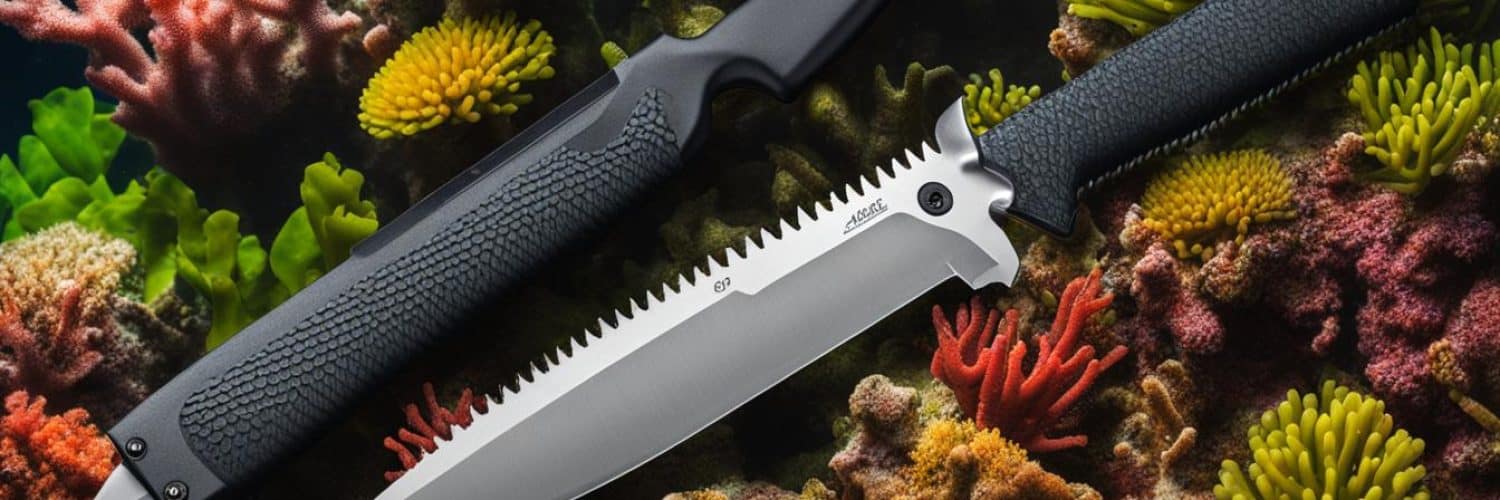A scuba knife is an indispensable tool for divers, providing safety, functionality, and versatility in the underwater world. Whether you’re exploring reefs, spearfishing, or navigating through kelp forests, having the right scuba knife can make a significant difference in your dive experience.
When choosing a scuba knife, there are several factors to consider. The material of the knife, such as stainless steel or titanium, determines its durability and resistance to corrosion. The type of blade, whether fixed or folding, affects reliability and accessibility. The edge of the blade, be it straight or serrated, determines its cutting capabilities. And the tip of the blade, whether blunt, sharp, or tanto, influences its safety and usefulness in various situations.
Size is another crucial consideration, as a knife should be compact enough for hassle-free handling while providing accessibility underwater. Proper maintenance, including rinsing and drying after each dive, is essential to prevent corrosion and ensure the knife’s longevity. Sharpening the blade regularly and checking the locking mechanism are also important for optimal performance.
Ultimately, a scuba knife should always be used responsibly and primarily as a safety tool, never as a weapon or to harm marine life or habitats. With the right scuba knife by your side, you can enhance your safety, tackle unexpected situations, and make the most of your diving adventures.
Key Takeaways:
- Choose a scuba knife made from corrosion-resistant materials like stainless steel or titanium.
- Consider the type of blade (fixed or folding) based on reliability and accessibility.
- Decide between a straight or serrated edge depending on the cutting tasks you anticipate.
- Select a blade tip that suits your safety preferences and specific diving activities.
- Ensure the size of the knife is appropriate for your needs and easily accessible during dives.
Importance of a Diving Knife for Safety and Versatility
A diving knife is not only a valuable tool but also a safety device for divers. It serves multiple purposes, including freeing divers from entanglements caused by kelp, netting, monofilament, and rope.
Unforeseen objects underwater can pose risks to divers, and a quality, serrated-edge knife can provide a means of escape in such situations. Additionally, a diving knife is useful for fishing beneath the ocean’s surface, as it can be used to break up chum, loosen scallops, spearfish, or fillet catches.
As a tool, a diving knife can serve as a light pry bar, screwdriver, hammer, or equipment modifier when other tools are not available. Overall, a diving knife is indispensable for a safe and enjoyable scuba diving experience, providing divers with the necessary means to handle unexpected situations and tasks underwater.
Materials: Stainless Steel vs. Titanium Dive Knives
When considering a dive knife, divers often have the option between stainless steel and titanium blades. Stainless steel knives are known for their ease of sharpening and affordable price range. However, they require more maintenance to prevent rusting and corrosion.
On the other hand, titanium knives are lightweight, extremely strong, and resistant to corrosion. They are considered maintenance-free and are ideal for divers who frequently dive in saltwater environments. While titanium knives can be more challenging to sharpen, their durability and rust resistance make them popular among divers.
Ultimately, the choice between stainless steel and titanium depends on personal preference, diving conditions, and budget.
Types of Blade: Fixed Blade vs. Folding Blade
Dive knives are available in two primary designs: fixed blade and folding blade. Each type offers distinct advantages and considerations for divers.
Fixed Blade Dive Knife
A fixed blade dive knife is widely regarded as more reliable and easier to access and use with one hand. These knives commonly come with a sheath, ensuring safe storage and convenient underwater retrieval. The fixed blade design provides stability and durability, making it a popular choice among divers seeking a robust and dependable tool.
The fixed blade dive knife is praised for its reliability and ease of use with one hand, making it a trusted companion for underwater exploration.
Folding Blade Dive Knife
On the other hand, folding blade dive knives offer the advantage of compactness and enhanced safety during transportation. The folding mechanism allows the blade to be folded into the handle, reducing its overall size and making it easier to carry. This design is particularly beneficial for divers concerned about storage space or potential accidental injuries caused by an exposed blade.
However, it’s worth noting that opening a folding blade knife with one hand can be more challenging compared to a fixed blade knife. Divers considering a folding blade knife should ensure they are comfortable with the opening mechanism and practice proper handling techniques.
Comparison: Fixed Blade vs. Folding Blade Dive Knives
| Fixed Blade Dive Knife | Folding Blade Dive Knife |
|---|---|
| Reliable and sturdy | Compact and portable |
| Easy one-handed access | Reduced risk of accidental injury |
| Comes with a sheath for safe storage | Easier to carry and store in limited spaces |
| Ideal for divers requiring ruggedness and durability | Suitable for divers prioritizing ease of transport |
Ultimately, the choice between fixed blade and folding blade dive knives depends on personal preference and specific diving requirements. Whether you prioritize reliability, accessibility, or compactness, there is a knife design available to suit your needs.
Edge of the Blade: Straight vs. Serrated
Dive knives come in two main variations when it comes to the edge of the blade: straight and serrated. Each type has its own advantages and is suitable for different underwater tasks.
A straight blade is perfect for slicing tasks such as cutting plastics or nylon rope. It provides a clean cut and is versatile for various diving applications, making it an essential tool in the diver’s arsenal.
On the other hand, a serrated blade is designed for sawing through tougher materials, including natural fibers and kelp. The serrations on the blade create more friction, enabling efficient cutting through these challenging substances.
Some dive knives offer a combination of both a straight and serrated edge, providing divers with the versatility to tackle different underwater tasks with ease. This dual-edge design allows for efficient slicing and sawing, making the knife suitable for a wide range of diving situations.
Additionally, having a notch in the blade specifically for cutting fishing line can be beneficial for divers who engage in fishing activities while diving. This feature ensures that the line can be easily and quickly cut, avoiding any entanglement or potentially dangerous situations.
Tip of the Blade: Blunt, Sharp, or Tanto
The tip of a dive knife blade plays a crucial role in its functionality and safety. Dive knives offer three types of blade tips: blunt, sharp, and tanto. Each tip design has its own advantages and considerations, catering to different diving requirements and preferences.
Blunt Tip
A blunt tip is a safer option, particularly for divers who prioritize safety and want to minimize the risk of accidental punctures. This tip design reduces the likelihood of damaging hoses, exposure suits, or BCDs during underwater tasks. Blunt tips are ideal for digging, hacking, and chiseling, making them versatile tools for various utility purposes.
Sharp Tip
Sharp tip knives are popular among spearfishermen due to their enhanced control and precision for fine cuts and spiking fish. They offer better penetration capabilities and can facilitate more accurate maneuverability when engaged in spearfishing activities. However, it’s important to handle sharp tip knives with caution, as they pose an increased risk of accidental punctures. Always carry sharp tip knives in a suitable sheath to prevent injury and maintain safety.
Tanto Tip
Tanto tip dive knives feature a hybrid design with a high point and a flat grind. This tip type provides strength and durability, making it capable of puncturing hard materials. Tanto tip knives are particularly useful in situations where the need for penetration and piercing is crucial. However, it’s important to note that compared to sharp tip knives, tanto tip knives may not have the same level of versatility for general utility tasks.
When selecting a dive knife with a specific tip design, consider your diving requirements, intended usage, and safety concerns. Ultimately, choosing the right tip design can enhance your safety and overall diving experience.
Size Considerations for Dive Knives
Choosing the right size of a dive knife is an important decision for divers. The size of a dive knife affects its compactness, accessibility, and versatility underwater. For recreational divers, a more compact knife is often preferred as it reduces the risk of entanglement and is easier to handle. A compact knife with a blade length of 3-4 inches (7-10 cm) is generally sufficient for cutting through nets and other materials that divers may encounter. It should also fit easily into a BC pocket for convenient access during dives.
However, for divers engaging in activities such as spearfishing or kelp diving, a larger knife may be necessary. These activities often require a more robust and powerful tool to handle the specific tasks associated with them. A larger knife provides divers with the necessary cutting power and leverage to navigate through dense kelp forests or deal with larger, tougher materials.
Regardless of the size chosen, it is essential to ensure that the knife can be reached easily and securely, even when wearing thicker gloves or other bulky equipment. Accessibility is crucial in emergency situations where a diver may need to quickly free themselves from entanglement or maneuver around obstacles underwater.
In summary, divers should consider their specific diving needs and preferences when choosing the size of a dive knife. For recreational divers, a more compact size is generally recommended for increased maneuverability and reduced entanglement risk. However, for specialized diving activities, a larger knife may be necessary to handle specific tasks effectively. Ensuring easy, secure accessibility to the knife is essential in all scenarios, prioritizing diver safety and the versatility of the tool in various underwater situations.
Dive Knife Maintenance Tips for Longevity
Proper maintenance is essential for ensuring the longevity and optimal performance of your dive knife. Follow these maintenance tips to keep your knife in top shape:
Rinsing and Drying
After each dive, rinse your dive knife with fresh water to remove salt and debris. Make sure to clean all areas, including the handle and sheath. Thoroughly dry the knife to prevent corrosion. You can use a soft cloth or towel to dry the blade and a can of compressed air to blow out any water from hard-to-reach areas.
Inspecting for Corrosion
Regularly inspect your dive knife for any signs of corrosion, such as rust spots or discoloration. If you notice any corrosion, use a mild cleaning solution or soft steel wool to remove it. Be careful not to scrub too hard, as this can damage the blade.
Checking the Locking Mechanism
Periodically check the locking mechanism of your dive knife and its sheath to ensure they are in proper working condition. The locking mechanism should securely hold the knife in place when not in use and release smoothly when needed. If you notice any issues, such as looseness or difficulty in locking or releasing, it’s important to address them promptly.
Lubricating the Locking Mechanism
Apply a small amount of silicone lubricant to the locking mechanism and the sheath to keep them functioning smoothly. This will help prevent any sticking or binding that may occur due to saltwater exposure.
Disassembling for Cleaning
Occasionally, disassemble your dive knife to clean any salt or sand that may have accumulated in the inner parts. Follow the manufacturer’s instructions for disassembly and reassembly to ensure proper handling and prevent any damage.
Sharpening the Blade
Sharpen your dive knife as needed to maintain its cutting performance. Use appropriate sharpening tools and methods based on whether your knife has a plain or serrated edge. Having a sharp blade will ensure clean cuts and efficient use underwater.
Protecting Against Corrosion
After each dive, consider coating the blade of your dive knife with silicone grease. This protective coating will provide an additional layer of defense against corrosion and help keep your knife in excellent condition.
By following these maintenance tips, you can extend the lifespan of your dive knife and ensure it remains reliable and ready for your underwater adventures.
Scuba Knife Options for Divers: Review and Recommendations
When it comes to scuba diving, having a reliable and effective dive knife is essential. There are numerous scuba knife options available on the market, each offering unique features and benefits for divers. We have reviewed and recommended the following dive knives:
- Cressi Skorpion Dive Knife: This versatile dive knife is made from corrosion-resistant stainless steel and offers a serrated back edge, line cutter, and a sharp front edge. It provides excellent functionality at an affordable price.
- ScubaPro Mako Titanium Diving Knife: Made from lightweight titanium, this compact dive knife features a serrated cutting blade, line cutter, and a versatile tip. It offers corrosion resistance and durability, perfect for divers who prioritize performance.
- Tusa X-Pert II Titanium Divers Knife: The Tusa X-Pert II is a titanium dive knife that combines a serrated back edge with a sharp front cutting edge. With a comfortable rubber grip, it offers durability, corrosion resistance, and lightweight design.
- Aqualung Squeeze Diving Knife: Known for its easy-to-use sheath mechanism, this dive knife has a 3-inch blade, line cutter, serrated edge, and a blunt tip. It is compact, reasonably priced, and ideal for divers seeking a convenient and efficient option.
- Spyderco Atlantic Folding Dive Knife: This unique dive knife features a folding blade with a rugged saw-like design. It is compact and easily portable, making it a reliable cutting tool for various diving situations.
- Promate Titanium Dive Knife: Made from medium-sized titanium, this dive knife offers a comfortable handle with extra grip. It is available in both blunt and pointed tip options and includes a line cutter and ridged back edge, providing versatility and high-quality performance.
- Cressi Borg Stainless Steel Divers Knife: With a full-sized 5.5-inch blade, the Cressi Borg dive knife comes in both drop point and blunt tip versions. It features a comfortable, non-slip rubber handle and a deep line cutter, ensuring secure storage with its one-hand release clasp sheath.
- Promate Barracuda Titanium Dive Knife: This high-end dive knife offers a sharp tip, line cutter, serrated and flat blade. With an ergonomic handle and thick titanium blade, the Promate Barracuda is a top-of-the-line choice for divers seeking exceptional cutting performance.
- Cressi Lima Dive Knife: The compact Cressi Lima dive knife is available in both stainless steel and titanium versions. It offers essential features in a smaller-sized blade, making it a popular choice among divers who value quality and affordability.
- US Divers Titanium Knife: Similar to the Promate Barracuda, this dive knife features a matte military finish and a sharp edge. With a full-sized blade, line cutter, and easy disassembly for cleaning, it offers high-quality performance and user satisfaction.
These dive knives provide a range of options for divers, catering to different preferences and requirements. Whether you prioritize affordability, durability, corrosion resistance, or specific features, there’s a scuba knife on this list that will meet your needs. Remember to choose a dive knife that suits your diving style and always prioritize safety and proper maintenance for optimal performance.
Conclusion
In conclusion, a scuba knife is an essential tool for divers, providing diving safety and acting as a versatile tool underwater. Whether you are looking for a knife that is suited for recreational diving, spearfishing, or other specific diving activities, there are many factors to consider when choosing the right scuba knife.
First and foremost, the choice of materials is crucial. Stainless steel and titanium are the most common materials used for dive knives. Stainless steel knives are easy to sharpen, while titanium knives offer durability and corrosion resistance. The decision on material depends on your maintenance preferences and the type of diving you engage in.
The blade type is another important consideration. Fixed blade knives are reliable and easily accessible, making them ideal for emergency situations. On the other hand, folding blade knives are more compact and easier to carry, providing convenience and safety. Consider your diving preferences and comfort level when selecting the blade type.
Maintenance is key to ensure the longevity of your scuba knife. Proper rinsing and drying after each dive, regular sharpening, and checking the locking mechanism and sheath are essential maintenance tips. By following these tips, you can prevent corrosion and keep your knife in optimal condition.
Based on our research and reviews, we recommend several dive knife options that cater to different needs and preferences. Some popular choices include the Cressi Skorpion and Cressi Borg for their versatility, the ScubaPro Mako and Promate Barracuda for their durability, and the Tusa X-Pert II and Spyderco Atlantic for their unique features. By selecting the right scuba knife and properly maintaining it, you can enhance your safety and enjoyment during dives.
FAQ
What is a scuba knife and why is it important for divers?
A scuba knife is an essential tool for divers, providing safety, functionality, and versatility underwater. It can be used to free divers from entanglements, serve as a fishing tool, and act as a general-purpose tool.
What are the factors to consider when choosing a scuba knife?
Divers can consider various factors, including the material, type of blade, edge of the blade, tip of the blade, and size when choosing a scuba knife.
What are the common materials used for scuba knives?
Titanium and stainless steel are commonly used materials for scuba knives, each with its own advantages and considerations.
What are the types of blades available for dive knives?
Dive knives come in two main types: fixed blade and folding blade. Each type has its own advantages and considerations.
What is the difference between a straight blade and a serrated blade?
A straight blade is ideal for slicing tasks, while a serrated blade is designed for sawing through tougher materials. Some dive knives offer both options for versatility.
What are the different types of tips available for dive knives?
The tip of a dive knife blade can be blunt, sharp, or tanto. Each type of tip has its own advantages and usage considerations.
How important is the size of a dive knife?
Size considerations for dive knives are important, as a more compact knife is often preferred for recreational divers, while larger knives may be necessary for specific diving activities.
What maintenance tips should I follow for my dive knife?
Proper maintenance, including rinsing with fresh water, drying, regular inspection, sharpening, and lubrication, is essential for ensuring the longevity and optimal performance of a dive knife.
What are some recommended scuba dive knife options?
Recommended dive knife options include the Cressi Skorpion, ScubaPro Mako, Tusa X-Pert II, Aqualung Squeeze, Spyderco Atlantic, Promate Titanium, Cressi Borg, Promate Barracuda, Cressi Lima, and US Divers Titanium knives. Each knife offers its own features and benefits.
How important is a scuba knife for divers?
A scuba knife is an essential tool for divers, providing safety, versatility, and functionality underwater. It is a valuable safety device that can help divers handle unforeseen objects, entanglements, and serve as a fishing tool.
What are the advantages and considerations of stainless steel and titanium dive knives?
Stainless steel knives are easy to sharpen and affordable, but they require more maintenance to prevent rust and corrosion. Titanium knives are lightweight, extremely strong, and resistant to corrosion, making them ideal for saltwater environments. However, they may require more effort to sharpen.







Add comment